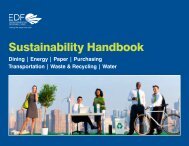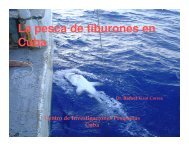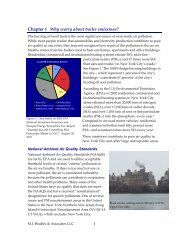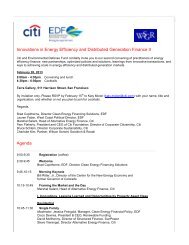Program Overview [PDF] - Environmental Defense Fund
Program Overview [PDF] - Environmental Defense Fund
Program Overview [PDF] - Environmental Defense Fund
You also want an ePaper? Increase the reach of your titles
YUMPU automatically turns print PDFs into web optimized ePapers that Google loves.
Reducing Global Warming Pollution Through Community Action<br />
California’s Global Warming Solutions Act (AB 32) requires cutting climate changing<br />
emissions by more than 30% by 2020. To meet this important objective, we must<br />
reduce emissions from every sector of the economy and in every community.<br />
The State of California has established a framework to slash emissions from major<br />
industrial sources such as oil refiners and power and cement plants. We need a<br />
mechanism to enable small emitters to be part of the solution as well.<br />
Climate for Community is a pilot program that demonstrates how households<br />
and small businesses can contribute to California’s pollution reductions goal and be<br />
rewarded financially for their efforts. San Francisco Community Power and<br />
<strong>Environmental</strong> <strong>Defense</strong> <strong>Fund</strong> have launched the program in partnership with more<br />
than 500 small businesses and households. San Francisco Community Power pilots<br />
innovative programs that improve our neighborhoods' environmental and economic<br />
conditions. <strong>Environmental</strong> <strong>Defense</strong> <strong>Fund</strong> is a national environmental group that<br />
co-sponsored California’s Global Warming Solutions Act.<br />
1107 9th Street<br />
Suite 540<br />
Sacramento, CA 95814<br />
916.492.7070<br />
Saving the Environment, One Community at a Time<br />
2325 3rd Street<br />
Suite 344<br />
San Francisco, CA 94107<br />
415.626.8723<br />
Climate for Community<br />
Empowering Everyday People to Fight Global Warming<br />
The Technology & Design Center at Lick Wilmerding High School produces solar electricity, uses recycled building<br />
materials, and emphasizes the use of natural daylighting, while reducing global warming emissions and electricity<br />
and heating costs.<br />
For additional information and technical notes please visit:<br />
www.edf.org/C4C<br />
www.sfpower.org<br />
Totally chlorine free 100% recycled (50% post consumer) paper<br />
Photography: Rebecca Wilkowski Graphics: Daniel Mckenzie<br />
Energy auditing creates green jobs. SF Power's audit team prepares for a day of house calls.
Creating Community Benefits From Cap-and-Trade<br />
A key reduction strategy under AB 32 is the creation of a cap and trade market that<br />
will place a statewide cap on global warming pollution. Polluters must find ways to<br />
bring their emissions below the cap through direct reductions or purchase of allowance<br />
credits. Individuals and small businesses can play a vital role in achieving reductions<br />
that can be sold in cap-and-trade allowance markets.<br />
Working together, households and businesses can combine their efforts to access<br />
emissions allowance markets that return economic rewards to their community<br />
through a simple three-step process:<br />
1. Achieve emissions reductions through a variety of strategies, including energy<br />
efficiency investments and behavior changes such as using public transportation<br />
instead of private vehicles.<br />
2. Verify emissions reductions and sum up reductions from many community<br />
members.<br />
3. Create emissions credits for sale in allowance markets to return economic rewards<br />
to those who reduced their emissions. Communities can generate benefits in the<br />
form of cash or additional emission reduction investments, such as efficient<br />
appliances or renewable solar power generation.<br />
Businesses and Households Gain by Cutting Climate Pollution<br />
To get participants started in the Climate for Community program, a climate audit<br />
expert identifies actions and ideas for reducing emissions, and provides a kit of emissions<br />
saving devices. The expert then verifies that participants are taking actions that reduce<br />
emissions, such as replacing inefficient equipment and energy-wasting appliances,<br />
improving energy use practices, reducing vehicle miles traveled and conserving water.<br />
Many Small Actions Make a Big Difference<br />
Thirteen million households and more than three million small businesses account<br />
for more than one-fifth of California’s annual greenhouse gas emissions.<br />
California's 2007 Carbon Dioxide Emissions by Sector<br />
Residential<br />
Buildings<br />
14%<br />
Commercial<br />
Buildings<br />
8%<br />
Industrial Manufacturing<br />
Construction and Mining<br />
12%<br />
Agriculture<br />
Food Processing<br />
9%<br />
Other<br />
7%<br />
Climate for Community provides participants with a<br />
cost-saving emissions reduction kit.<br />
Simple devices like sink faucet aerators reduce water<br />
flows, save money, and avoid greenhouse gas<br />
emissions from treating, transporting and heating water.<br />
Oil and Gas<br />
Extraction/Refining<br />
14%<br />
On-Road<br />
Vehicles<br />
36%<br />
Collective Action is Vital to Success<br />
Although one home or one business may not achieve significant greenhouse gas reductions,<br />
pooling actions across communities will add up to significant reductions with considerable<br />
economic value. In addition to earning allowance credit revenue, households and small<br />
businesses that take action to fight global warming will:<br />
• Reduce pollution in their neighborhoods.<br />
• Lower their energy, water, and waste bills and transportation costs.<br />
Community-wide reductions could prove especially helpful for low-income communities<br />
that are often impacted disproportionately by pollution and high utility rates. Climate for<br />
Community will simultaneously provide incentives for environmental improvements and<br />
return money to communities that need it most.<br />
Achieving just a 10% reduction from these sources would reduce global warming<br />
emissions by roughly 12 million tons by 2020 – equal to the reductions anticipated<br />
from our entire agriculture and forestry sectors. Pooling emissions across communities<br />
enables households and small businesses to enjoy the economic incentives for<br />
emissions reductions that are created by emissions allowance markets.<br />
Climate for Community<br />
Good for the environment, families and small businesses.


![Program Overview [PDF] - Environmental Defense Fund](https://img.yumpu.com/34005758/1/500x640/program-overview-pdf-environmental-defense-fund.jpg)
![Annotated bibliography [PDF] - Environmental Defense Fund](https://img.yumpu.com/50613332/1/190x245/annotated-bibliography-pdf-environmental-defense-fund.jpg?quality=85)

![What do we mean by MSY? [PDF]](https://img.yumpu.com/49525661/1/190x245/what-do-we-mean-by-msy-pdf.jpg?quality=85)

![Print version [PDF] - Environmental Defense Fund](https://img.yumpu.com/46812189/1/190x201/print-version-pdf-environmental-defense-fund.jpg?quality=85)
![Mercury Alert: Cleaning up Coal Plants for Healthier Lives [PDF]](https://img.yumpu.com/45587786/1/190x143/mercury-alert-cleaning-up-coal-plants-for-healthier-lives-pdf.jpg?quality=85)




